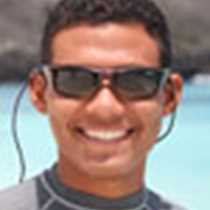The Galapagos archipelago is a magical place where people from all over the world come to experience the wildlife that once inspired Darwin and his theory of natural selection.
There are times in life when enjoying an early morning rise with the sun makes one content. This morning kayakers started along the coast of Española as the sun started to rise above the cloud cover. Large Opuntia prickly pear cacti were visible along the cliffs of Española as the occasional Pacific green sea turtle popped their head above the surface for a breath of air. The deep turquoise layers of water surrounded us as we returned to our floating home after a spectacular kayak outing. After a flurry of obtaining snorkeling gear we are off again to snorkel from our Zodiacs along the coast of Gardner islet. Young Galapagos sea lions decided that we were somewhat odd in the water as they swam circles around us. Small diamond sting rays hovered over the sandy bottom as they upturned the sandy bottom for small crustaceans for their meal. As we headed for deeper water we encountered a kaleidoscope of invertebrates upon the islands wall which disappeared into the depths below. Beach goers watched the drama and comedy of the sea lion pups as they lumbered back and forth on the beach looking for their mothers, who were most likely busy foraging for food offshore. As we returned mid-day to the ship, an Española mocking bird was busily running between our legs searching for anything that may be of subsistence.
Navigation into the afternoon brought us to the only other National Park site on Española, Suarez Point. During this full moon the waves were slightly higher and the coast is awash in sea foam. As we started out on the hike over boulders, most are surprised to find that the dense population of wildlife does not even move as we walk among them. Marine iguanas are brightly colored with bright green and red patterns upon their bodies and appear to be randomly placed along our path. Large Nazca boobies are perched along the southern cliffs and we find swallow tailed gulls and red billed tropic birds flying to and from their nesting areas. Mist is felt by some as the waves are compressed into a crack in the basalt coastline and vapor is shot up into the air. In the distance the open ocean had thousands of miles of undulating movement until landfall. As the Sun dipped in the distance a pair of Galápagos hawks scanned the land below them for nourishment and a light breeze cooled us at last as we returned to our home on the water.







